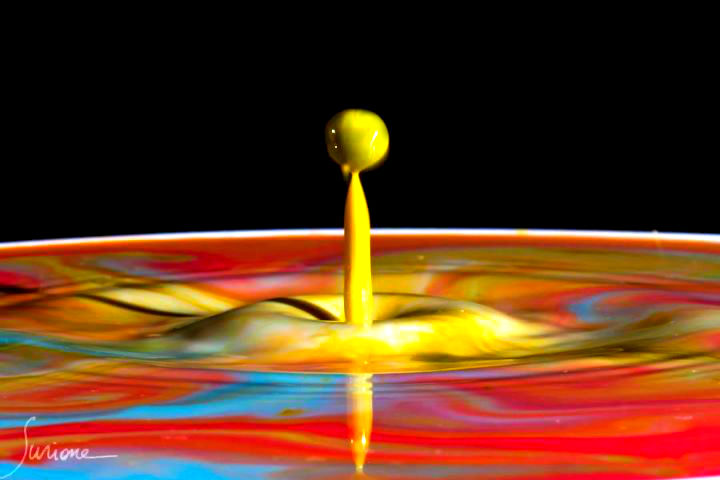[Bruce] built his own high-speed photography equipment for a fraction of the price it would have cost him to purchase it. He was inspired by a friend who showed him some example images. He headed into his shop and built an Arduino-based high-speed flash controller.
To capture an image like this one the camera is placed in a dark room and set for a long exposure. At just the right instant the flash is activating, capturing the image. In this case [Bruce] used an infrared laser diode pointed at a phototransistor to trigger the flash. When the droplet breaks the laser beam the Arduino triggers the flash after a calculated delay. It’s not specifically covered in his guide, but [Bruce] also mentions that this can be modified to use sound as a trigger. Here’s another sound-activated flash controller if you need inspiration.
The image at the top was made by dropping dye from a pipette into a pool of water. If you don’t have a pipette on hand you can head over to our LIFE blog to make one out of heat shrink tubing.
















Nice!, I really like that
Ah, so it’s using a laser as the beam-break for triggering.
Sorry, I got my hopes up with the headline thinking that they’d managed to construct an RGB laser setup to actually be the “flash” (don’t see why not, could probably generate a very high-power, short-lived burst that is very controllable and predictable – a proper flash/strobe can be as well but possibly not as perfectly)
Wouldn’t it be a short exposure? Long exposure with a flash would only cause the droplet to blur due to the long exposure time.
I guess its long exposure because they’re using a flash.
Well look proper at the picture, the droplet is indeed blurred.
Not sure why this is claimed to be high speed, because there is nothing high speed about a regular flash being fired (usually around 125ms to discharge) – proper high speed is in the ns range.
To be honest, theres nothing really amazing about this project; head over to http://www.cameraaxe.com/ and you can pick one up for yourself (both preassembled and as a break it yourself kit). Added bonus, with a cameraaxe, you can time the shutter and the flash to achieve a somewhat closer to high speed shot (get the shutter to complete its drop while the flash is still on (remember 125ms is a long time when dealing with light).
Huh, that website recommends using lots of small flashers, presumably because smaller xenon tubes have lower inductance. Wonder why they don’t mention the gold standard of fast cheap flash photography even though most of their example pictures are taken with it … air gap. They are afraid people will electrocute themselves?
http://en.wikipedia.org/wiki/Air-gap_flash
Although it doesn’t seem to explain this in the Instructable, it’s the *shutter* that is open for a long exposure. Since it’s in a dark room, the sensor is only exposed while the flash is going off (the *short* exposure, which is why there is not much motion blur).
This technique is useful when it’s not possible to synchronize the flash and shutter. Additionally, the flash sync rate is usually limited to about 1/200 s anyways, so keeping the environment dark and relying on a flash is great for freezing motion.
When the area is lit up by the flash, it will be “frozen” in time even with a long exposure. As long as the flash output is set high enough and the exposure ends shortly after the flash occurs. I bet they have the camera set to “bulb” mode where the exposure time is set manually (it can be started and stopped via remote, for example).
The shutter is left open in a dark room and the image is captured when the flash fires (when the droplet breaks the beam).
Nice pics, but surely it should be “frikkin’ lasers”!
Can’t you just trigger the shutter instead of the flash in daylight?
yes if your camera can handle and external trigger
Yes with caveats, but mostly NO.
Triggering the shutter instead of the flash presents a number of additional complications. First there is a delay with some variation between the moment the shutter is triggered and when it actually opens. These delays vary between models and types of cameras, and there is enough variation within a single camera to make the timing difficult. This is particularly a problem when dealing with true high speed photography (few microseconds), but can be workable when using standard xenon flashes (where durations are at best tenths of a millisecond).
Building a truly high speed flash is relatively easy. 15-20KV power source, a decent capacitor, and a trigger circuit. You can find plans in old Scientific American magazines. Also search for Edgerton. The trigger is the easy part, don’t even need a microcontroller–seach hiviz.com…
Of and true, ‘high speed’ photographs are usually measure in a few microseconds duration, not the nanoseconds someone mentioned above. Typically to get to the nanosecond range requires a much more expensive/difficult chemical shutter system. As well as an abnormally bright light source. The most common/available examples are the nuclear explosion photographs from the 40’s where the light source was the explosion and the cameras used kerr cell shutters.